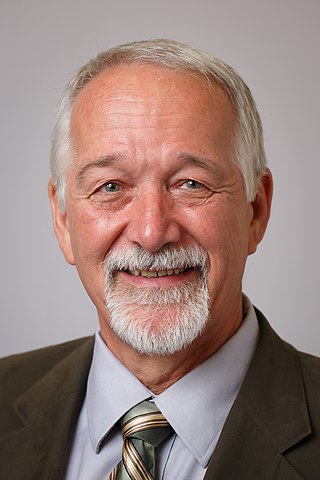External links
- Homepage of Tamás Szőnyi
- page of the finite geometry research group
- members of the mathematical committee of the HAS
Tamás Szőnyi (born July 23, 1957, Budapest) is a Hungarian mathematician, doing research in discrete mathematics, particularly finite geometry and algebraic coding theory. He is full professor at the department of computer science of the Eötvös Loránd University, Budapest, vice director of the Institute of Mathematics, and vice chairman of the mathematical committee of the Hungarian Academy of Sciences. In 2001, he received the Doctor of Science title from the Hungarian Academy of Sciences. Szőnyi created a successful school in finite geometry. He has done influential work on blocking sets [1] and the polynomial method. [2]
Combinatorics is an area of mathematics primarily concerned with counting, both as a means and an end in obtaining results, and certain properties of finite structures. It is closely related to many other areas of mathematics and has many applications ranging from logic to statistical physics and from evolutionary biology to computer science.

Béla Bollobás FRS is a Hungarian-born British mathematician who has worked in various areas of mathematics, including functional analysis, combinatorics, graph theory, and percolation. He was strongly influenced by Paul Erdős since the age of 14.

Endre Szemerédi is a Hungarian-American mathematician and computer scientist, working in the field of combinatorics and theoretical computer science. He has been the State of New Jersey Professor of computer science at Rutgers University since 1986. He also holds a professor emeritus status at the Alfréd Rényi Institute of Mathematics of the Hungarian Academy of Sciences.

In mathematics, tropical geometry is the study of polynomials and their geometric properties when addition is replaced with minimization and multiplication is replaced with ordinary addition:

László Lovász is a Hungarian mathematician and professor emeritus at Eötvös Loránd University, best known for his work in combinatorics, for which he was awarded the 2021 Abel Prize jointly with Avi Wigderson. He was the president of the International Mathematical Union from 2007 to 2010 and the president of the Hungarian Academy of Sciences from 2014 to 2020.
László Fejes Tóth was a Hungarian mathematician who specialized in geometry. He proved that a lattice pattern is the most efficient way to pack centrally symmetric convex sets on the Euclidean plane. He also investigated the sphere packing problem. He was the first to show, in 1953, that proof of the Kepler conjecture can be reduced to a finite case analysis and, later, that the problem might be solved using a computer.

László Rédei was a Hungarian mathematician.
Van H. Vu is a Vietnamese mathematician, Percey F. Smith Professor of Mathematics at Yale University.
János Kollár is a Hungarian mathematician, specializing in algebraic geometry.
Zoltán Füredi is a Hungarian mathematician, working in combinatorics, mainly in discrete geometry and extremal combinatorics. He was a student of Gyula O. H. Katona. He is a corresponding member of the Hungarian Academy of Sciences (2004). He is a research professor of the Rényi Mathematical Institute of the Hungarian Academy of Sciences, and a professor at the University of Illinois Urbana-Champaign (UIUC).

Gábor Tardos is a Hungarian mathematician, currently a professor at Central European University and previously a Canada Research Chair at Simon Fraser University. He works mainly in combinatorics and computer science. He is the younger brother of Éva Tardos.

Jenő Elek Egerváry was a Hungarian mathematician.
György Elekes was a Hungarian mathematician and computer scientist who specialized in Combinatorial geometry and Combinatorial set theory. He may be best known for his work in the field that would eventually be called Additive Combinatorics. Particularly notable was his "ingenious" application of the Szemerédi–Trotter theorem to improve the best known lower bound for the sum-product problem. He also proved that any polynomial-time algorithm approximating the volume of convex bodies must have a multiplicative error, and the error grows exponentially on the dimension. With Micha Sharir he set up a framework which eventually led Guth and Katz to the solution of the Erdős distinct distances problem.

Tamás Erdélyi is a Hungarian-born mathematician working at Texas A&M University. His main areas of research are related to polynomials and their approximations, although he also works in other areas of applied mathematics.

In mathematical optimization, the criss-cross algorithm is any of a family of algorithms for linear programming. Variants of the criss-cross algorithm also solve more general problems with linear inequality constraints and nonlinear objective functions; there are criss-cross algorithms for linear-fractional programming problems, quadratic-programming problems, and linear complementarity problems.
Endre Boros is a Hungarian-American mathematician, a Distinguished Professor at Rutgers University in New Brunswick, New Jersey, and the Director of the Center for Operations Research (RUTCOR). He is the author of 15 book chapters and edited volumes, and 165 research papers. He is Associate Editor of the Annals of Mathematics and Artificial Intelligence, and Editor-in-Chief of both the Annals of Operations Research and Discrete Applied Mathematics.
In geometry, specifically projective geometry, a blocking set is a set of points in a projective plane that every line intersects and that does not contain an entire line. The concept can be generalized in several ways. Instead of talking about points and lines, one could deal with n-dimensional subspaces and m-dimensional subspaces, or even more generally, objects of type 1 and objects of type 2 when some concept of intersection makes sense for these objects. A second way to generalize would be to move into more abstract settings than projective geometry. One can define a blocking set of a hypergraph as a set that meets all edges of the hypergraph.
Lynn Margaret Batten was a Canadian-Australian mathematician known for her books about finite geometry and cryptography, and for her research on the classification of malware.
Combinatorics of Finite Geometries is an undergraduate mathematics textbook on finite geometry by Lynn Batten. It was published by Cambridge University Press in 1986 with a second edition in 1997 (ISBN 0-521-59014-0).

Tamás Terlaky is a Hungarian-Canadian-American professor of Industrial and Systems Engineering at Lehigh University. He is especially well known for his work on criss-cross algorithms, interior-point methods, Klee-Minty examples for path following algorithms, and optimization.